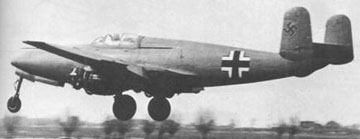
Heinkel He 280
A german turbojet fighter, the first of all that could have been operational. Maiden flight on april, 5th, 1941. Heinkel, always interested in high speed aircraft, sponsored quite early the turbojet development of von Ohain and had because of this advantage the first experimental turbojet plane (He178) in flight. The He280 was a twinjet fighter developed for two He S8 (also called He109-001) radial turbojet engines. It had a modern bow-wheel landing gear (conventional ones caused problems with lifting up the tail without the propeller air stream on the horizontal fins) and an ejection seat. The german ministry of aviation (RLM) was quite upset of Heinkel´s private initiative and set up its own turbojet program, favoring competitors (that were´nt so far advanced) concerning both engine and airframe development (BMW, Jumo and Messerschmidt). This had as major result that the He S8 hadn´t enough development priority, and that´s why the heavier but stronger Jumo109-004 and BMW109-003 engines and the Me262 fighter (by far not as maneuvrable as the He280, which outmaneuvred a Fw190 in a mock dogfight, and in 1941 with conventional wings and landing gear). The He280 was a fighter, the Me262 just a heavy interceptor that could slip through the escorts. Nine prototypes, no others.
My comment:
The really interesting thing - except that it could have been operational short after Me262´s maiden flight - is its maneuvrability. The Me262 was
designed for top speed, yes, even more speed than useful (with 150km/h twice as much speed advantage than necessary for dogfight superiority).
It wasn´t usual to curve in a Me262 with more than a 45° angle (usual around 80°!), its acceleration was low, its Mk108 armament was especially
good for destruction of medium to heavy bombers at close distance only and it had a 50% higher weight and wing load.
The Me262 shot down some fighters like P-51D, but in the hands of aces like Galland!
The He280 instead had similar maneuverability like the Fw190A (wingload 4125kg : 21.5m2 = 191kg/m2, less than Fw190D!) and was
with its speed advantage and good armament most probably the best dogfighter of World War 2, especially in hit-and-run tactics.
The HeS08 and BMW109-003 engines had better handling and provided better acceleration than the Jumo109-004.